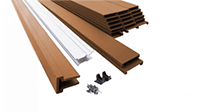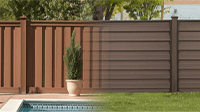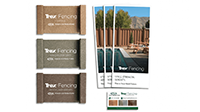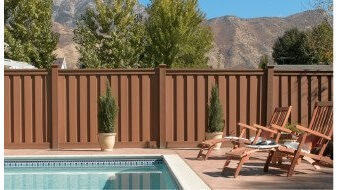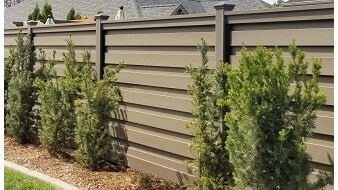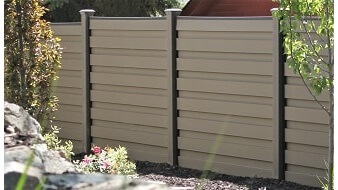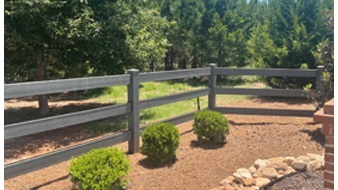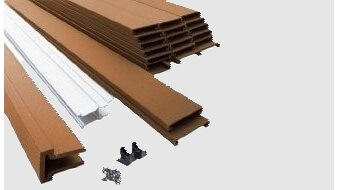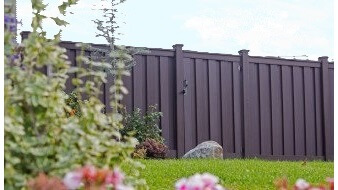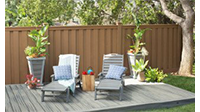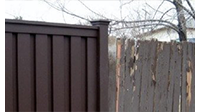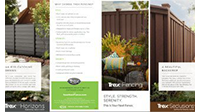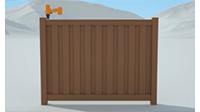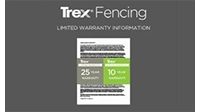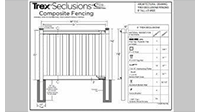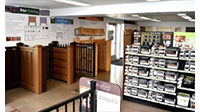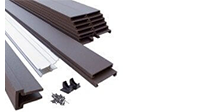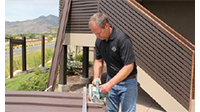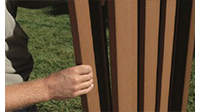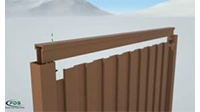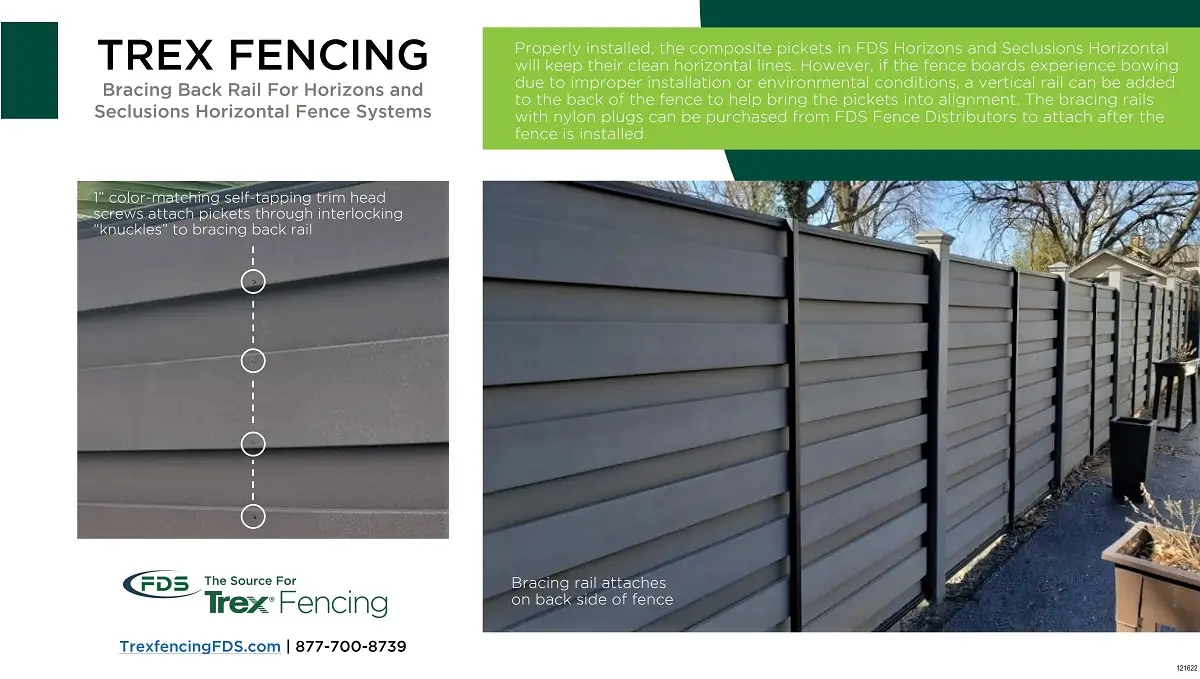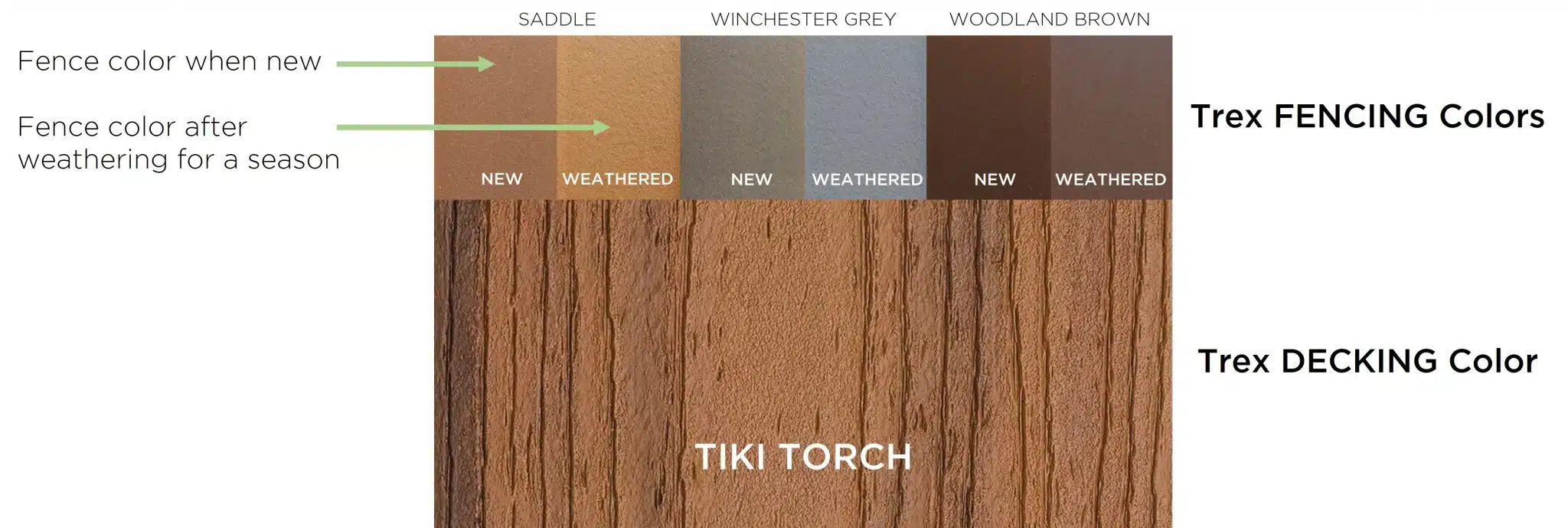Are Heavy Duty Hinges Available?
FDS Distributors offers heavy duty hinges for large gates fabricated by FDS. Our standard hinges will work for all gate up to 6′ tall in standard and large widths. We recommend heavy duty hinges for gate panels over 65-1/2″ wide or for any width for gates over 6′ tall.
The FDS Heavy Duty Hinge is sold in sets of two. The hinges are made of black power-coated stainless steel (some parts of the hinge are not black coated). They are not self-closing.
Note: All Trex gate hardware sold by FDS are compatible with FDS-fabricated gates and Trex composite 5″ x 5″ composite fence posts. They may not be compatible with other products. Trex fence posts used for the hinge side of a gate should always have a steel post stiffener inside. With heavy duty hinges, a 3.5″ x 3.5″, 7-gauge square tube stiffener should be used (available from FDS).
Our Heavy Duty Hinge (part number TrexHinge-HD)

How do I fix bowing or warping in my horizontal fence?
As discussed in other articles, one of the challenges of any horizontal fence, whether wood, plastic, or composite, is making sure the rails stay true both vertically and horizontally. The Horizons (and, similarly, Seclusions Horizontal) fence system takes advantage of the metal frame components and interlocking design to keep the pickets from distorting. However, improper installation or high humidity and heat may cause the pickets to swell, which can cause bowing. There are a few essential steps and remedies to deal with this issue.
Pre-installation considerations to avoid bowing
Shorter Post Centers
For installations in high heat and humidity, if you have not yet finalized your project plan and purchase, consider shortening the width of the sections. The shorter the distance between the vertical posts, the lower the possibility of picket flexing, and if the pickets do bow, it will be less noticeable.
Preventative measures during installation
Leaving gaps to allow for expansion
If you have already purchased your materials, be sure to follow the instructions regarding expansion as as noted in the installation guide. A gap of at least 3/8″ of an inch on each side of the fence panel is necessary to allow the pickets to expand (reference Step 7B in the installation guide). Since the post centers are 97″ (and therefore 92″ between posts), typically there will be sufficient room for the standard 91″ board to fit with gaps without trimming. However, extruded composite material like Trex pickets can vary slightly in length and therefore may not be exactly 91″, so check the measurements of your pickets before installing them to make sure they are no more than 91″ in length. If you are installing the fence in cold dry weather, bear in mind that even though the pickets may have sufficient room now, in hot and humid weather they may not.
Ensuring pickets interlock
Trex pickets are designed to interlock. This not only gives the fence its unique design and added strength, it also helps the pickets keep their form. Therefore, if the bottom picket sits too high and cannot interlock, some adjustments will be necessary. First, evaluate if you can achieve the results you are looking for by using fewer pickets. If fewer pickets gives you too much of a gap under the fence, you can rip the last picket to make sure the top of the bottom picket interlocks with the picket above it (be sure ALL pickets interlock). You should never rip any picket except the one at the bottom of the fence. This picket will be screwed to the metal horizontal bottom rail which will give it the rigidity lost by ripping the bottom edge off the picket. Here is what the bottom rail will look like after ripping the bottom and screwing it to the Horizons bottom rail. Your measurements will vary depending on how much room is left at the bottom after installing all the remaining pickets. Keep in mind that it is best to have approximately 1″ of clearance at the bottom to avoid constant contact between the ground and the metal bottom rail. If the fence is installed in an area with water-saturated soil that is likely to heave and come in contact with the bottom of the fence, consider a bigger gap underneath.

Our Horizons Installation Guide provides more details in regards to general installation, measurements, instructions, etc.

Resolving bowing if the fence is already installed
If the fence was not installed properly and the pickets have bowed because the boards weren’t cut to provide the necessary expansion gaps or the pickets are no longer interlocked, the fence may need to be unassembled to allow reinstall correctly. Usually, only Steps 7B through 9 are necessary, although it may also be necessary to rip the bottom picket as described in the section immediately above this one.
If the Horizons fence pickets won’t relax after the boards are cut to allow for the necessary gaps (permanent deformation may occur if the pickets have been bowed for an extended period of time), a vertical back bracing rail can be applied. This component helps to bring the pickets back into alignment. On the back side of the fence, screw the bracing rail to the top and bottom Horizons horizontal rails. Then, fasten screws from the other side through the composite pickets into the back bracing rail. To make sure you screw through the pickets into the back bracing rail, temporarily attach a string to the middle of the to top rail and pull it tight over the front of the fence panel, then pull the string through the bottom and attach it in the middle of the bracing rail at the bottom of the fence. This creates a straight line that you can use as your guide to fasten the screws. Only fasten the screws through the pickets that touch the back bracing rail. Use self-tapping screws with color matching heads for best results (FDS can supply these with the back bracing rail upon request).
Part Numbers for Vertical Back Bracing Rail application:
- TFHMSB-8 = Vertical Back Bracing Rail (Vendor description: “Horizons Mid Span Brace Black”)
- TFHMSB-Cap = Caps for Back Rail
- Screws: DFES350JB = Woodland Brown, DFES350GY = Winchester Grey, DFES350BN = Saddle
- Paint-Textured = Paint to touch up any exposed metal
Where is the steel frame inside the FDS pre-built gate?
The galvanized steel frame is situated 1″ in from the edge of Trex gates built by FDS Distributors. The frame is 1-1/4″ steel tube, so the center point is 2-5/8″ in from the edge of the gate. When attaching hardware, whether parts from the FDS gate packages or third-party products you will apply after the fact, be sure to attach into the frame with self-tapping screws. The composite is not meant to suppor the function of hinges, latches or other gate components. Here is an cutaway illustration of the interior of the gate.

Does Trex make lattice panels?
Trex does make a lattice. Trex’s licensed partner, Acurio Latticeworks, manufactures a lattice system that can be used for a variety of purposes in conjunction or separately from Trex’s other products. For example, like other types of lattice panels, Trex Latticeworks can be added to a Trex fence to create a beautiful semi-privacy design. A popular style is full privacy at the bottom of the fence panel using Trex’s standard pickets and rails, then lattice privacy panel between a mid-rail and the top rail. Trex Latticeworks can be cut to fit sections of whatever length is needed and it comes in a variety of heights. While Trex lattices cannot be ordered from us, you can visit Trex LatticeWorks for more information.
Looking for ideas on how build Trex Fencing with lattice panels? See the link to a related article with a suggestion for a lattice installation concept.

Can I put lattice on top of my Trex Fence?
Many customers want to put a decorative piece on top of their fence, such as lattice of some kind. While we do not offer any of those products, decorative pieces can be added to compliment your Trex Fence with some creativity. You can view our Gallery to see some of the creative ways customers have customized our fencing. Trex does offer Lattice panels that can be ordered separately as well.
 One important thing to note is that you will want to check your local codes or HOA rules to make sure that you are not exceeding any height restrictions for your community.
One important thing to note is that you will want to check your local codes or HOA rules to make sure that you are not exceeding any height restrictions for your community.
How to make a lattice panel on top of my Trex Fence
Here is a concept on how to add a lattice panel to your Trex Fence. Using a second top rail, two additional bracket, and pieces cut from extra pickets, you, could easily build this design.
Instructions:
Decide on the height of the panel you want and purchase your own panels accordingly. We suggest using a lattice panel that is no thicker than 1/4″ so you can use pieces of Trex pickets to wedge the panel into place.
Build the privacy portion of the Trex fence by cutting down the pickets to the desired height. Finish off the pickets with a top rail which will serve as your mid rail.
Rip cut the “knuckles” off extra pickets. You will use these as supports to sandwich the lattice panel on top of the mid-rail and to wedge the lattice panel inside the top rail channel.
Place the top rail over the lattice and secure every in place with finish nails or trim head composite screws.
Note: since a customer would be combining a self-sourced third-party product with Trex and ultimately devising their own design, this is offered as a suggestion only to give the customer an idea of a potential method of building a Trex fence with lattice panels.

Do you have steel post stiffeners with base plates?
While Trex posts are designed to be stand-alone posts in most applications, there are certain scenarios in which a steel reinforcement would be necessary and recommended. For instance, we recommend using a post stiffener when a Trex gate is going to be hung off of a post. Another common scenario is when customers are wanting to mount Trex Fencing onto a concrete pad, wall, or their deck/patio. In these cases, we offer post stiffeners of various sizes that include a welded base plate so that the stiffener can be anchored to the concrete.
The size of fence you are mounting will determine how heavy duty of a stiffener is needed.
- For a 6’H fence, consider our standard galvanized 24” mount with 3.5” x 3.5” base plate and holes that are 9/16” in diameter *

These mounts work fine as long as the fence is not being installed in a high wind area. We do, however, offer stiffeners that are heavier duty to support fences that are either a) in high wind areas or b) taller than 6’H. Due to the sheer weight and size of a fence at those heights, you are going to want a post stiffener that can successfully provide structural support.
For these types of scenarios, we offer heavy duty 7 gauge post stiffener with a welded base plate to anchor the stiffener to the concrete. These post stiffeners are the same as the ones we use for our large gates. They are different from our C-channel 12 gauge stiffeners that are used for our standard gates.
- The galvanized heavy duty post stiffener comes in either 108” or 144” heights, and are 3.5” x 3.5” *

- The galvanized plate that is welded to the base of the stiffener is 8” x 8” and is 3/4” thick. The plate holes are 3/4” in diameter and fit a 5/8” anchor *


Heavy duty stiffeners with base plates are not available to order on our website, but can be ordered by calling and ordering over the phone with one our sales associates at 877-700-8739. Our sales team members are also technical experts and can help answer any questions you have for your project, including how to make sure your fence is installed in a way to ensure structural integrity.
* Note: Steel post stiffeners and the base plate installation methodology are not included in standard installation guidelines and are not covered by warranty.
Find complementary Trex fencing and decking colors
What color in the fencing line pairs best with your Trex deck? That depends on your style sensibilities, but we’re here to help you make an informed decision. Visit our Complementary Colors page to see color swatches with each decking color next to the three fencing colors (both before and after weathering). Order samples for an even better side-by-side comparison.
How do I clean sap off my fence?
How do you clean a Trex fence?
Typical cleaning of a dirty Trex fence usually only requires using a bucket of soapy water, a soft bristle brush, and a hose. The dirt usually comes off easily and the fence looks fantastic after the cleaning. Some foreign materials such as graffiti or sap may take more effort to clean. Importantly, we do not recommend pressure washing the fence as that will likely damage the fence. Consult the Trex Fencing Care and Cleaning guide for more advice on cleaning a dirty fence.

What are steel post stiffeners?
Trex Fencing posts typically do not need stiffeners or inserts. The exceptions would be for fences taller than 8′ and for the hinge side of a gate. Two types of post stiffeners are used with Trex fencing and gates.
C-Channel Hinge Post Stiffener (TPFI)
This stiffener is designed for use with gates up to 6′ tall and widths up to the Large Standard size (65-1/2″ wide), and that have a fence section on the opposite side of the gate hinge post*. One end is open to allow the brackets for a section of fence to be attached on the opposite side without interference. The 12-gauge galvanized steel is available in 9′ lengths.
* A section of fence on the opposite side of the hinge post helps to keep the hinge post plumb by acting as a counter balance).
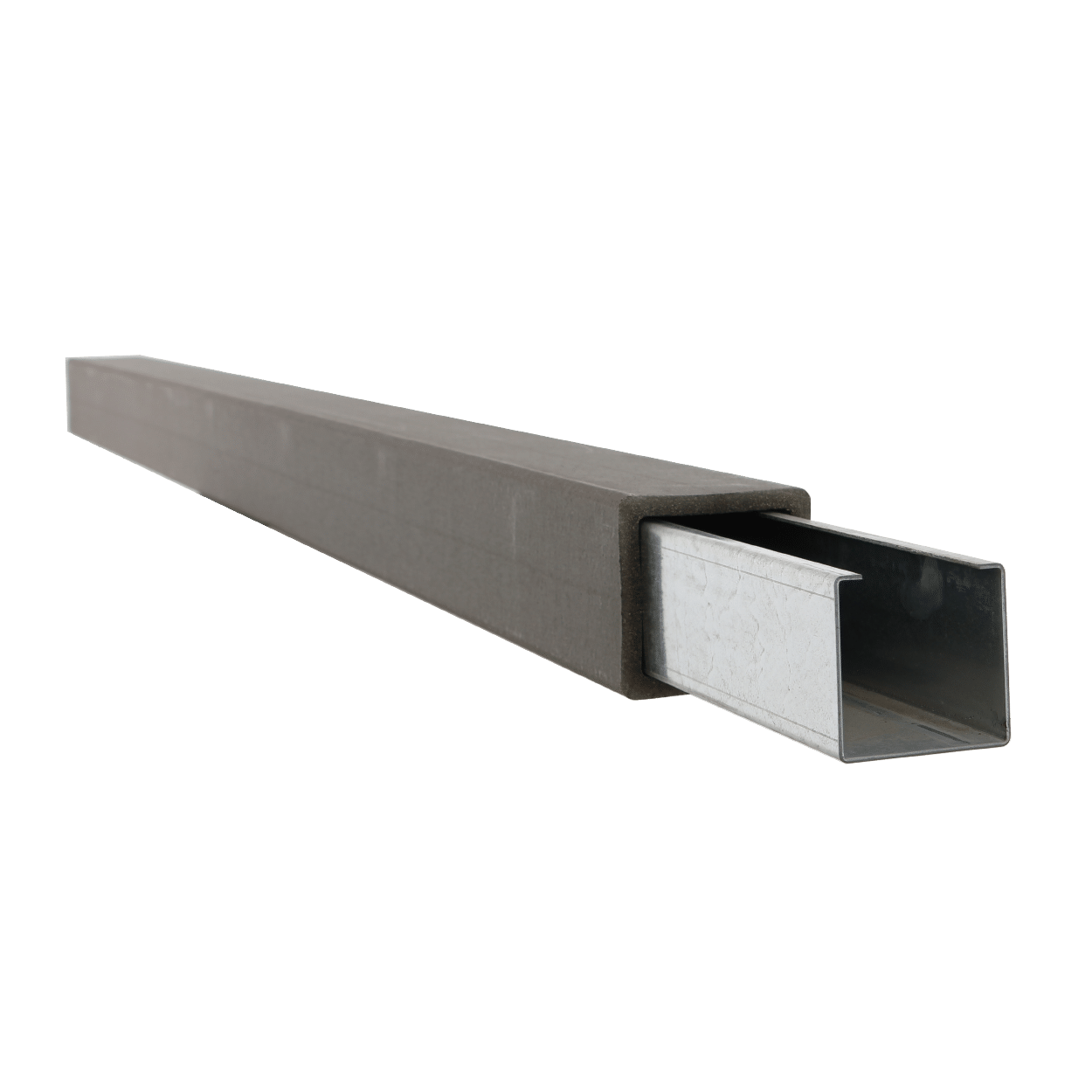
Heavy Duty Post Stiffener (TPFIHD and TFPIHD12)
This stiffener is used for large gates, fences taller than 8′, when the hinge post is a standalone post, and when a fence line does not run parallel on the opposite side of the hinge post.
The heavy duty stiffener can be embedded in a concrete pad with the Trex composite post sleeved over the top. The 7-gauge (.188″ thick”) square tube is made of galvanized steel. Note, a ring is welded inside the square tube. This does not serve any purpose for the installation of a Trex fence. It is used to hang the tube as it is dipped for galvanization. The heavy duty stiffeners are available in 9′ (TFPIHD) and 12′ (TFPIHD12) lengths. Self-tapping screws will need to be used when attaching fence brackets (if applicable) to the hinge post.
Note: Heavy duty hinges are available for gates larger than 6′ wide and with heights more than 6′ tall.
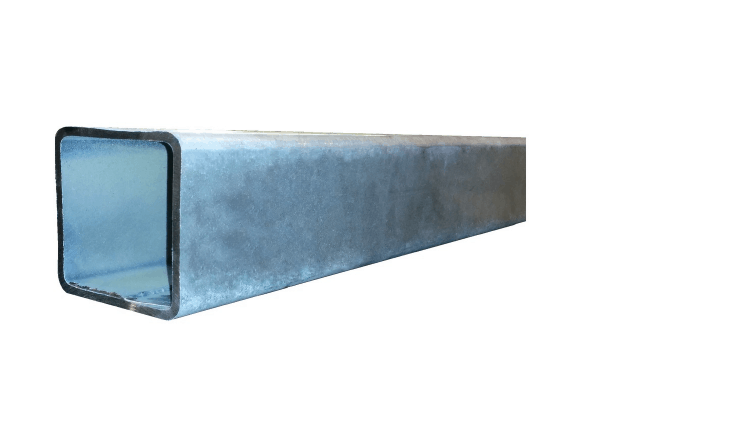
How do I figure how much material I need for my fence?
Figuring or calculating your materials isn’t hard if you understand the basics of how to create a layout and use your measurements. With any fence, including Trex, the general principle of figuring out how many posts, rails, pickets, etc., is as follows:
A “section” of fence is defined as a post (and cap) and all of the materials you need before the next post. With Trex, it’s easy, we sell materials as unassembled “kits” so everything you need between the posts is included.
Here are two images that will give you instructions on how to figure how much material you need for your property.
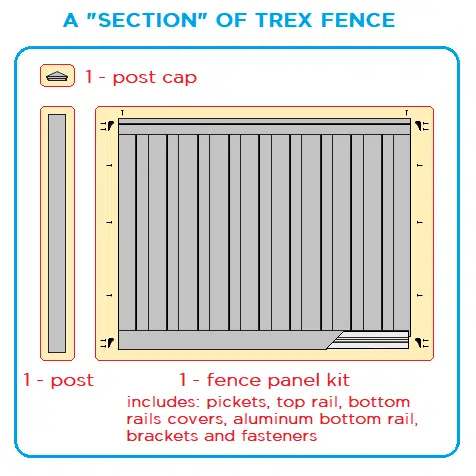
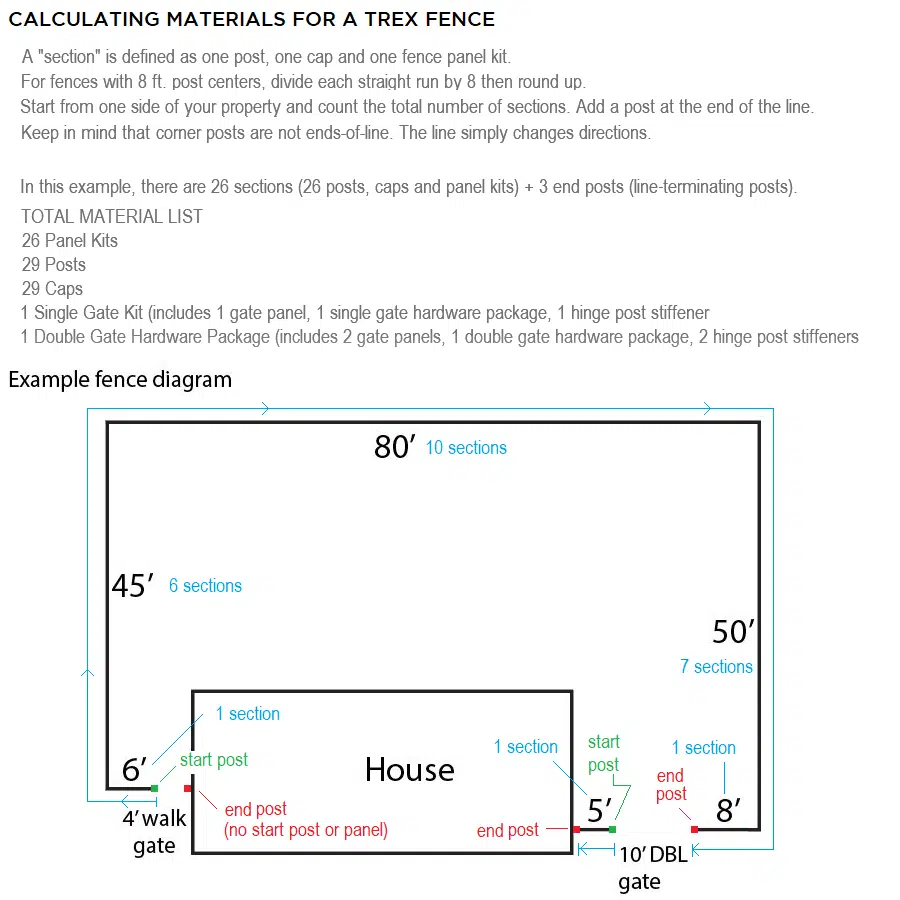
Can I use a Trex post as a sleeve?
Unlike wood fence posts, Trex is hollow in the center and has a wide enough dimension to use the Trex post as a sleeve. The post is designed to be a self-supporting component so it wouldn’t be necessary to reinforce them, except where applicable*, but the hollow post allows it to be used interchangeably as a sleeve.
A Trex post has an outer dimension of 5″ x 5″ with a 5/8″ wall. The inner dimension is 3-3/4″ x 3-3/4″ which is wide enough to allow the Trex post to sleeve over most nominal 4″ x 4″ posts or a steel pole. This design gives a consumer a lot of options for installation. A Trex post can sleeve over a pressure treated wood post on a deck which would then allow a builder to cut the panel kit components to create a privacy railing or screen. A Trex post could be sleeved over galvanized steel posts embedded into a concrete wall or pad so the fence would be built on top without having to core out a hole for the post. A Trex post could be sleeved over a 4×4 structural support post for a deck before the deck is built to provide a much more attractive and thicker looking post than the wood inside. NOTE: Trex Fencing posts are not the same as railing posts. The components are not compatible with each other. Search for article on railing sleeves.
Learn more about Trex Fencing posts.

* Trex posts used to mount hinges for a gate require a steel post stiffener. Gates made from Trex composite components are heavy and because they move, there is significant torque on the posts used to attach hinges. Additionally, stiffeners are necessary for fences over 8′ tall to extend the depth of the post hole sufficiently to support a tall fence.
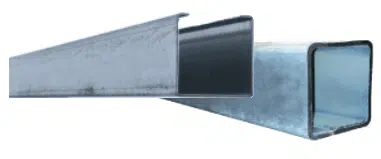
Is there a warranty on the Trex Gates?
Trex’s 25-year residential warranty does not cover our Trex gates and hardware as a whole, as there are metal components that are not comprised of Trex composite material, and are thus cannot be vouched for by Trex. However, the individual composite pieces of the gate are covered under the terms of the warranty.

For example, a gate hinge that breaks would not be covered under warranty. Neither would latches or handles that break due to either excessive abuse or natural wear and tear.
 A Trex composite component piece that degrades due to a manufacturing defect, however, would potentially be covered under warranty, and while the whole gate itself would not be replaced, a claim could be made for that individual component to be replaced. Pieces that brake or fracture due to use would not be covered under warranty.
A Trex composite component piece that degrades due to a manufacturing defect, however, would potentially be covered under warranty, and while the whole gate itself would not be replaced, a claim could be made for that individual component to be replaced. Pieces that brake or fracture due to use would not be covered under warranty.
 Any questions? Call 877-700-8739 to talk to one of our experts.
Any questions? Call 877-700-8739 to talk to one of our experts.
Are Trex Fencing Posts the same as Trex Railing Posts?
The Trex railing sleeves are not the same product as the fence posts. The Trex railing sleeves are a plastic-heavy composite that look more similar to a vinyl material than the Trex composite material used for the fencing and the core of the decking products. The railing components are used strictly as sleeves (sliding over 4×4 or 6×6 nominal posts attached to a deck). They cannot be used as standalone posts, whereas the Trex Fencing post is meant to be a self-supporting component. The hollow cavity of the Trex Fencing post does give it the ability to be used as a sleeve if needed such as to allow the insertion of a steel post stiffener for gate hinge posts.
PLEASE NOTE: We are the distributor for Trex Fencing only. Our team is not able to answer questions about the railing components or systems. Please contact 800-289-8739 to speak directly to a Trex representative or contact your local decking and railing supplier.
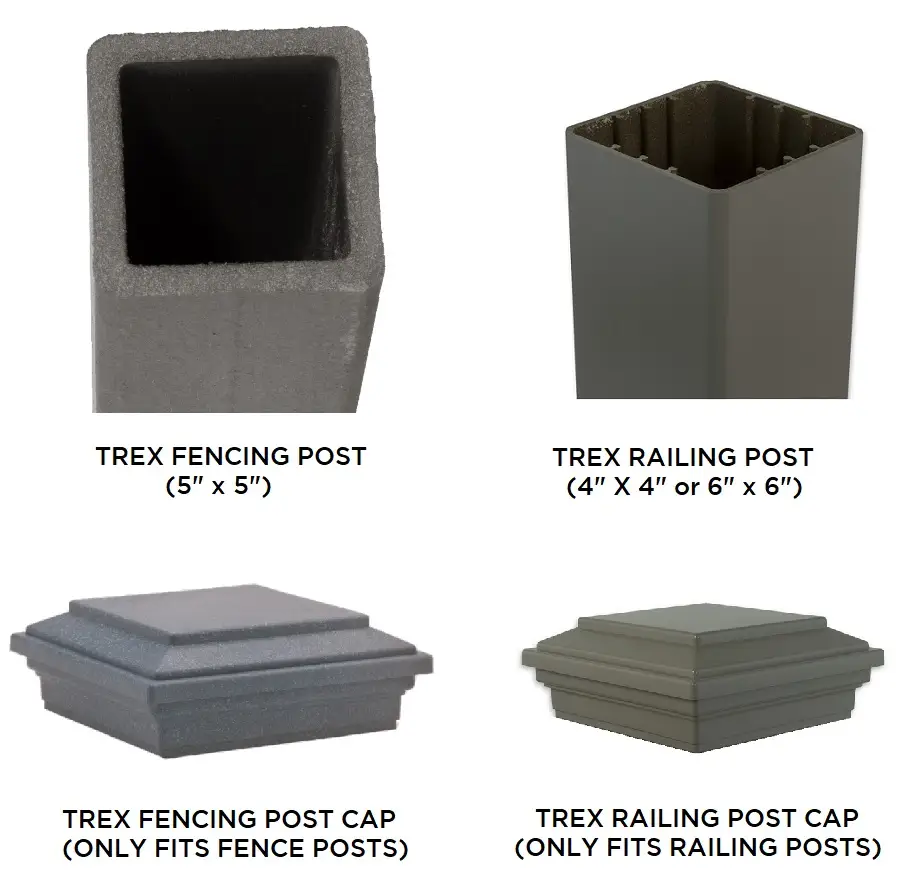
Does the color of a Trex Fence fade or have variation?
The color of Trex Fencing fades to a degree through a natural weathering process. Color fading in general is a well known phenomena that occurs when plastic and pigments are exposed to UV light. To counter the full impact of sunlight, the product is over-pigmented during manufacturing and engineered to maintain pigmentation throughout its life. As a result of this practice, the fencing arrives significantly darker and in a different hue than it will be once it has had an opportunity to weather (this is particularly noticeable in Winchester Grey which has a brownish color when it is new). Trex engineers have worked with pigmentation over the years to set a specific color value during production to allow the product to fade from its original color to an intended lighter color which is still vibrant, attractive, and natural looking.

The majority of the fading typically takes a season of exposure to the sun. After initial weathering has occurred, any additional fading is minimal and Trex will retain color throughout its life. You can learn more by visiting Trex Fencing Colors on our website.
Note regarding variation: Some variation may exist between the individual components. This occurs because the recycled material in Trex composite comes from a variety of sources and can interact differently with the pigmentation. Variation is not considered a manufacturing defect and is not covered under warranty. To learn more, see our Trex Fencing Colors page. If you prefer to minimize variation, group pickets of similar hues.
Note regarding post caps: Post caps are not manufactured in the same facility as the rest of the Trex composite components. The raw material content and manufacturing of the caps is also a bit different than the rest of the fence. The caps are created with molds and therefore require a different formulation than the other components which are extruded. Because of the distinct ways the pigment is applied to the profiles as they are manufactured, the caps may look different when new than the rest of the fence. This difference is particular noticeable on a Winchester Grey fence when it is first installed but becomes much less visible as the fence weathers (example of a new fence with a new cap)
—
To help you visualize what to expect, here are examples of weathering over time:
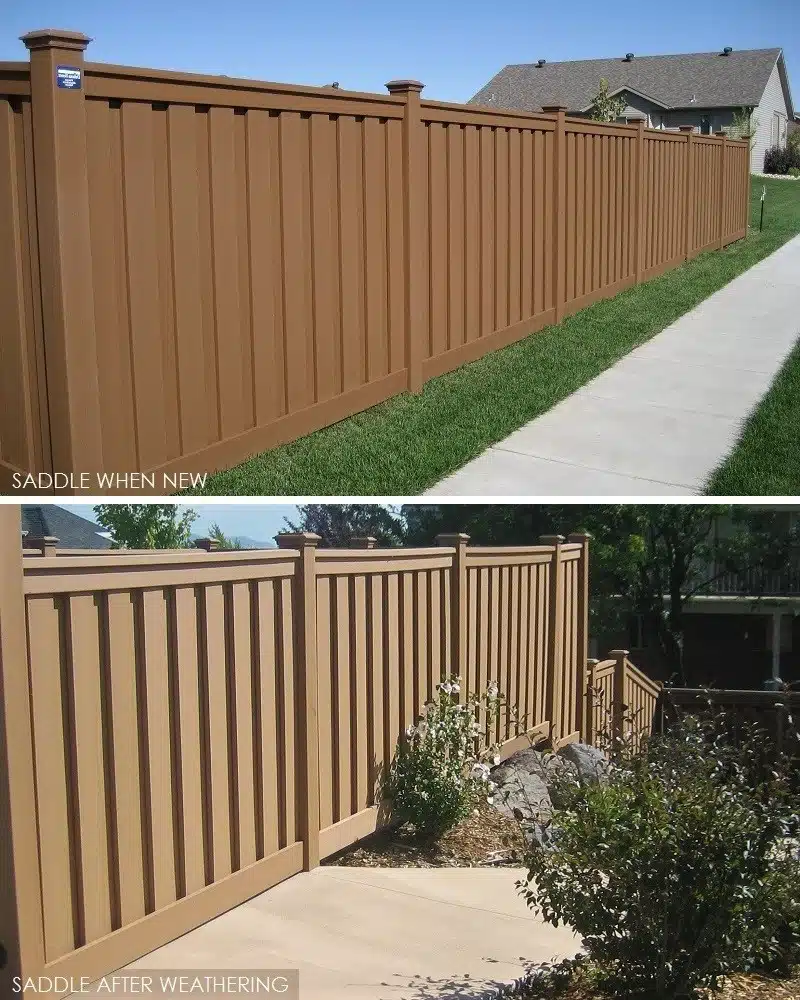
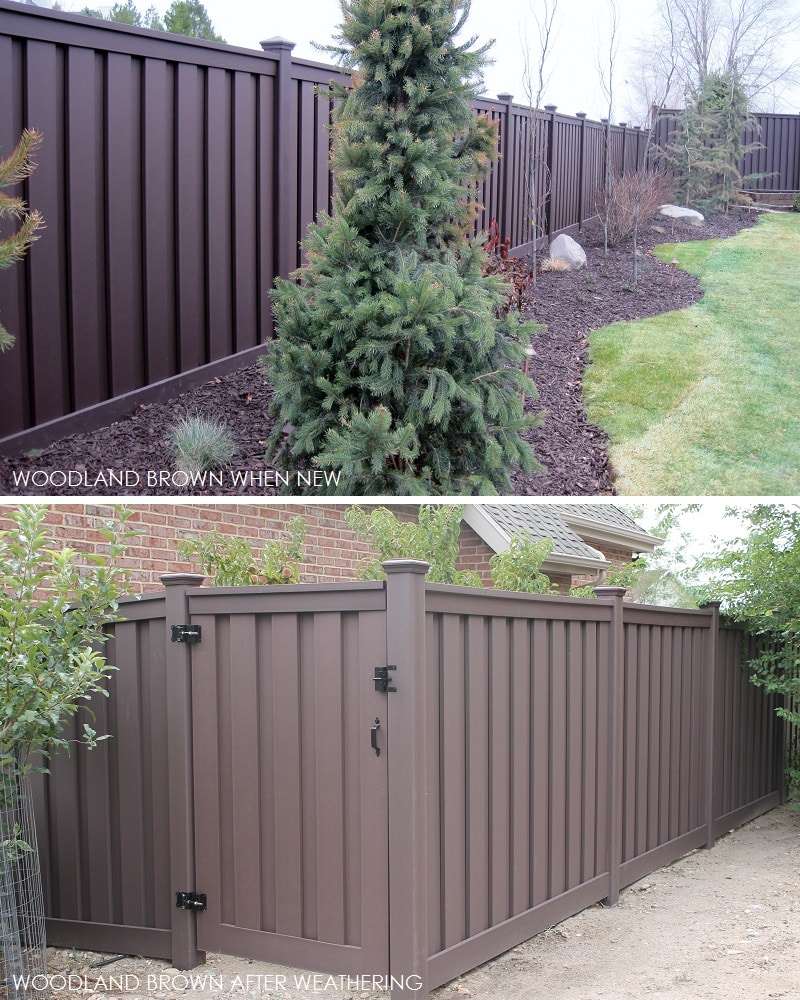
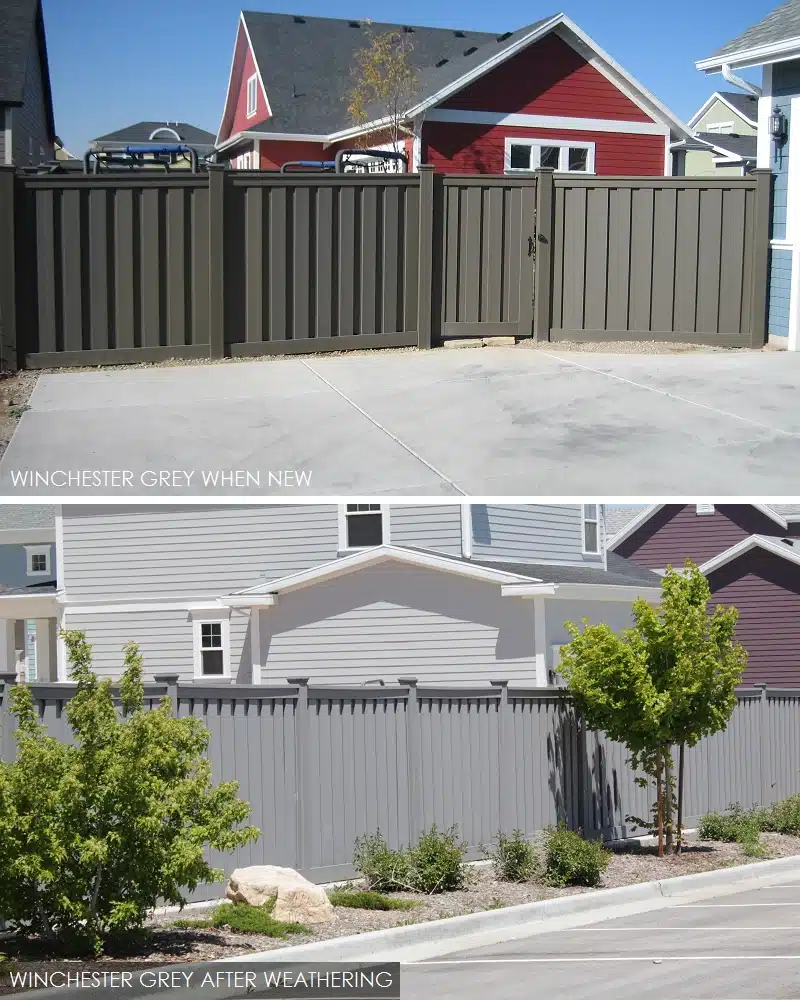
What is in Trex composite fencing?
Trex composite fencing is a combination of materials, primarily plastics and wood. The thermoplastic content (a type of plastic polymer that can be melted down and recycled almost indefinitely) is primarily polyethylene from reclaimed/recycled grocery bags and stretch film. The wood fiber is typically obtained from furniture makers and/or waste pallets, and is a mix of hardwood and softwood sawdust. The recycled/reclaimed portion of the product makes up approximately 95% of the material with roughly half of that content in plastic and the other half in wood. The remaining 5% is a combination of pigmentation and adhesives (proprietary glues to bind the wood and plastic). The finished product is a decay-resistant, durable material that are extruded to create the profiles that make up a Trex fence.

What is the material used for fence brackets?
Trex fence brackets are made of high strength material called glass-filled nylon. By adding powdered glass to the nylon resin or extruding the plastic with glass fibers, the raw material in glass-filled nylon takes on several beneficial properties:
-
- Material stiffness is up to 80 percent greater than common plastics
-
- Tensile strength is up to 70 percent greater than common plastics
-
- The thermal expansion rate that is roughly half of unfilled nylon, providing increased stability when exposed to temperature changes
- The hardness is 50 percent greater than common plastics
Trex Fencing bracket material and the bracket design were used in the development of the component specifically because they offer far superior performance benefits over a metal or standard plastic component. Combined with the 5/8″ wall thickness of a Trex post, Trex fence brackets add to the overall strength of the fence system, handling high wind loads and common incidental stress from low impact events (such as balls kicked against the fence or lawnmower bumps) that happen across the life of a fence.
How do I mount a Trex fence on top of concrete?

Trex Fencing can be mounted on top of a concrete pad or retaining because the hollow post design allows the Trex post to sleeve over the top of an embedded component such as a heavy duty steel pipe or wall mount. Because the inside dimensions of Trex posts are 3-3/4” x 3-3/4”, the post can sleeve over preexisting mounts and anchored onto concrete.
There are several methodologies to mount Trex posts on top of concrete. Here are two concepts. Please note that these do not constitute official installation instructions from Trex or FDS. They are provided as guidelines. We encourage all customers to evaluate their installation needs to determine if the methods and applications you are planning to use will be viable options.
We do offer concrete post mounts that serve their purpose well for our 6 foot high fences in most cases. But if you’re building a fence taller than 6 feet, or if you live in very windy areas, we do recommend using a mount that is designed to provide more stability.
In cases where the concrete has not yet been poured, heavy duty pipe can be set into the concrete and used as towers for Trex posts. This method is generally more secure than anchored mounts because the concrete holds the pipe without the risk of anchors pulling loose. Regardless of the mount method, you want the attachments to be sturdy and they need to fit the inside the dimensions of the Trex posts with some method of securing the post to the mount. If you have further questions, you can call our team of experts at 877-700-8739 and we would be happy to help you out.
Important note: Mounting a fence, Trex or otherwise, on top of concrete should be considered carefully. Ensure that your pad or wall are sufficient to support the fence. Anchors in a pad or on a narrow wall could break out with pressure from wind or other forces. If necessary, acquire engineering to determine if building a structure such as a privacy fence is a viable option for you.
This is an example of a poorly conceived project. In this case, the anchors for plated post mounts broke out the side of the concrete curbing after a post was mounted on top.

Will a fence block wind?
Depending on the design, a fence will block wind to a certain extent. Privacy fences are better at blocking wind, due to the fact that there are no spaces in between boards. The downside is that privacy fencing tends to act a sail and may be damaged by strong winds. Trex manufactures a high-end full privacy fence system that offers a list of virtues in addition to blocking wind. In fact, Trex has been tested to withstand hurricane force winds up to around 140 mph! Of course, it is important to remember that a fence only blocks wind if you are relatively close to the fence. Wind will travel over the fence and into your yard no matter the material you use.

Trex perform better overall in wind than most other fence systems, short of a stone wall. Vinyl fencing, for example, quite often will blow out in high winds. Wood fencing may break, especially if using a 4×4 post. The density and flexibility of the material give Trex the ability to take absorb the buffeting of high winds with lower instances of damage. Feel free to visit The Virtues & Benefits of Trex to better understand the value of Trex Fencing in addition to blocking wind.
 Note: Although Trex has performed quite well in high wind events, wind suppression is not the primary intended purpose of any fence system. It is important to consider what function you need your fence to serve and then find the fence system that best meets those needs. Fences, including Trex, do not cover wind damage in the warranty. High winds are localized environmental event and can act differently than in a test environment. The purpose of the wind load test is to give consumers the knowledge of how Trex fencing can perform overall in high winds.
Note: Although Trex has performed quite well in high wind events, wind suppression is not the primary intended purpose of any fence system. It is important to consider what function you need your fence to serve and then find the fence system that best meets those needs. Fences, including Trex, do not cover wind damage in the warranty. High winds are localized environmental event and can act differently than in a test environment. The purpose of the wind load test is to give consumers the knowledge of how Trex fencing can perform overall in high winds.
Is wind damage covered in the warranty?
Although Trex has performed quite well in high wind events, wind suppression is not the primary intended purpose of any fence system. It is important to consider what function you need your fence to serve and then find the fence system that best meets those needs. Fences, including Trex, do not cover wind damage in the warranty. High winds are localized environmental event and can act differently than in a test environment. The purpose of the wind load test is to give consumers the knowledge of how Trex fencing can perform overall in high winds.
Can I build a section wider than 8 ft on center?
The standard maximum width of a Trex Seclusions fence section is 96″ on center (the center of post to the center of the next post), which makes the span between posts 91″ nominal. It is always best to follow the standard installation guidelines, but if you need to (or have accidentally) set your posts further part, the method described in this link will help you adapt to the extra width. Using a combination of bands to cover seams and steel tubes to create longer internal rails, you can join pieces of Trex railing for extra width. For more details, download the instructions on how to create longer sections.

Do you have post skirts?

Trex Fencing posts are different than Trex railing posts. Just like the Trex Fencing system, the Trex railing system has its own complementary components including skirts for post bases. While skirts are not manufactured for Trex Fencing posts (fences in general don’t use skirts), Trex Fencing caps can be modified to create skirts. Using a plunge router or jigsaw, cut out the top of the mold to create a 5×5 hole. Flip it upside down before placing it. This will allow the modified cap to slide down over the post and rest at the base with the widest part of the new cap sitting on the surface as a skirt.
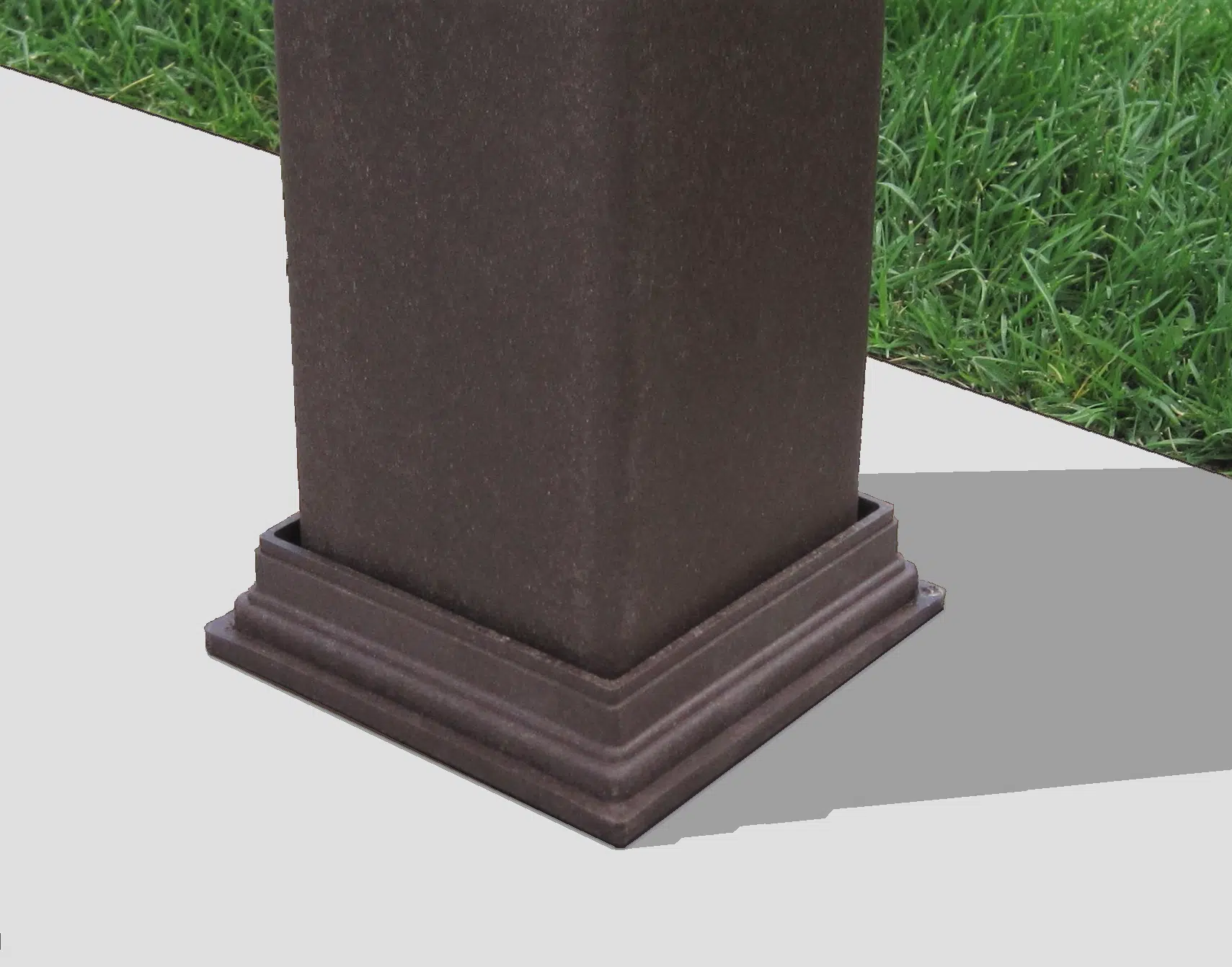
What spring is used for the gate latch?
The gate latches use zinc-plated music wire with the following specifications:
- Free length: .720”
- Wire diameter: .041”
- Outside diameter: .296
- Max load: 12.14 LB,
- Max length: 1.097”
- Open hooks on both ends
Note: while the zinc-plated spring has a long functional life, be cautious when installing the latch near bodies of salt water. If you want to replace the factory spring with a stainless steel component, you can purchase a third-party spring from other sources. A potential option is part number LEM100CA 01 S from Lee Spring. https://datasheets.globalspec.

Where is Trex Fencing made?
Trex Fencing is manufactured in Trex’s plant in Fernley, Nevada. From there, the material is placed on trucks and shipped up to our distribution facility here in Provo, Utah where it is sent out to customers all across the country.

From the beginning, Trex has been environmentally responsible. The composite material in its decking and fencing line is comprised of 95% recycled content in the form of reclaimed hardwood fibers and plastic film. Over 400 million pounds of plastic and wood is kept from landfills every year and almost 100% of all factory waste is reclaimed. Energy for manufacturing is primarily produced from natural gas, not petroleum sources, and its closed-loop systems save millions of gallons of water per year. No trees have ever been cut down to manufacture Trex products. Trex is also conscious of the additives used in the manufacturing process and does not use any chemicals harmful to the environment.
One of the easiest ways to reduce greenhouse gas emissions is to reduce the number of miles that trucks haul materials. Trex’s primary manufacturing facilities are located near geographical areas that have large quantities of raw source materials. This supply chain sustainability accounts for the materials used in the majority of all Trex products. Additionally, the manufacturing facilities use methods to reduce energy consumption and eliminate almost all factory waste through reclamation.
Trex and FDS Distributors have been partners in enhancing the outdoor living experience for close to two decades now. To better understand our relationship, as well as what role Trex company is playing in sustainable manufacturing, visit Trex Company and FDS Distributors.
Toggle titleIs Trex made in the U.S.A.?
Sources of Raw Materials and Manufacturing of Trex
All Trex® Decking, Railing, and Fencing products are manufactured in the USA.
Is Trex Fencing worth the cost?
When deciding if Trex Composite Fencing is worth the cost there are many factors to consider. Trex Fencing comes at a higher cost up-front when compared to wood and vinyl fence systems, because of it’s durability, natural beauty, flexibility in design, offered privacy, and its low maintenance. Material costs for a 6’H Trex Fence are about $55 per linear foot, gates excluded. If you are looking to have an installer put up your fence, you could be looking at anywhere from $75-95 per linear foot on average once you factor in labor costs. While the high price is a shock to many customers, they tend to discover that the amount of money saved in not having to repair, re-stain, and repaint their fence makes the cost of a Trex well worth it. Not to mention, you’ll get to relax in the summer months while your neighbors are spending Saturday mornings maintaining their fences.

In addition to saving money and sweat equity in maintenance, there are also advantages in aesthetics, serenity, and natural beauty that you can’t necessarily put a price tag on. As the following pictures demonstrate, Trex adds to a landscape’s design and appeal in incredible ways.


 Some fence materials can provide the beauty, others the durability, and others still the low-maintenance. But few materials can pull all three together quite like Trex Fencing. Not to mention, installation is relatively simple when compared to other fencing system. Trex is what you call a “stick-built” system, which means that the sections need to be assembled from individual components. But for all you amateur craftsmen out there, don’t let that scare you. Once your posts are in the ground, the pickets interlock using innovative “C channels”, and the top and bottom rails are bracketed onto the posts. The intuitive design makes installation a breeze.
Some fence materials can provide the beauty, others the durability, and others still the low-maintenance. But few materials can pull all three together quite like Trex Fencing. Not to mention, installation is relatively simple when compared to other fencing system. Trex is what you call a “stick-built” system, which means that the sections need to be assembled from individual components. But for all you amateur craftsmen out there, don’t let that scare you. Once your posts are in the ground, the pickets interlock using innovative “C channels”, and the top and bottom rails are bracketed onto the posts. The intuitive design makes installation a breeze.



If you’d like to to do a deeper dive into the installation process, feel free to look through our videos and guides found in our Installation Resources: Seclusions | Horizons
So let’s circle back to the original question: Is Trex Fencing worth the cost? Understandably, Trex is not for everyone. Depending on your budget, how long you plan on living at your current home, and a variety of other factors, it may not make sense for you to go with Trex. But let’s break it down this way:
Are you wanting a beautiful fence without the maintenance?
Are you looking to minimize costs associated with repairs?
Are you planning on living at your current location for at least another 10 years?
Are you interested in a DIY product that you can be successfully completed in a few weekends?
Are you wanting to be supported by a team of “Trexperts” that can help you every step of the way — from ordering to installation (that’s us!)?
If you answered yes to these questions, then Trex is definitely worth the cost. In fact, just from a practical standpoint, a high-end wood fence tends to become more expensive than Trex in the long-run:

Have more questions, or just need someone to talk to (about Trex, that is)? Then call our team at 877-700-8739. Looking for more information on how Trex Fencing stacks up to other products? Visit our comparison pages.
Can I rip or cut a Trex picket in order to get the width I want?
Though you can rip a Trex picket to get the width you want, this is strongly discouraged in most cases unless you are building a Horizons fence and the bottom picket needs to be trimmed for height (see detail below). Trex Fencing pickets offer a unique “C channel” design, providing much of the strength of the fence and it is crucial for a successful installation.

 In the case of either Seclusions or Horizons fence systems, there are times when adjusting the span of the fence section may be necessary. As previously stated, in the case of Seclusions, cutting or ripping the picket is not a viable solution. This is the same for Horizons, with one exception. So, if ripping the picket should be avoided in the majority of cases, what can you do to adjust the width of the fence? Let’s start with Seclusions first:
In the case of either Seclusions or Horizons fence systems, there are times when adjusting the span of the fence section may be necessary. As previously stated, in the case of Seclusions, cutting or ripping the picket is not a viable solution. This is the same for Horizons, with one exception. So, if ripping the picket should be avoided in the majority of cases, what can you do to adjust the width of the fence? Let’s start with Seclusions first:
Seclusions:
Instead of ripping the picket, you can adjust the spacing of the interlocking pickets and lock them in place with finishing nails or trim head composite screws in order to get the width you need for your section.

Importantly, many situations in which you would be shortening the span of the fence would require you to cut top and bottom rails to length, and then you would remove the needed amount of pickets from the section. Many customers cut their sections back in order to fit spaces that just would not work for a full 8 foot section.


You can view our Seclusions Installation Guide that explains how to adjust the spacing of your pickets in more detail. Look on pages 12 & 13 for instructions.
Ripped picket alternative:
If you prefer to rip the picket next to the post, cut the knuckle off the edge of the last picket to use as a C-channel against the post. The remainder of the picket can be ripped to fit into the channel. You will need to make sure the channel sits between the top rail and bottom rail so the ripped picket will fit in alignment with the rest of the pickets. Screw or tack the ripped picket to the knuckle.
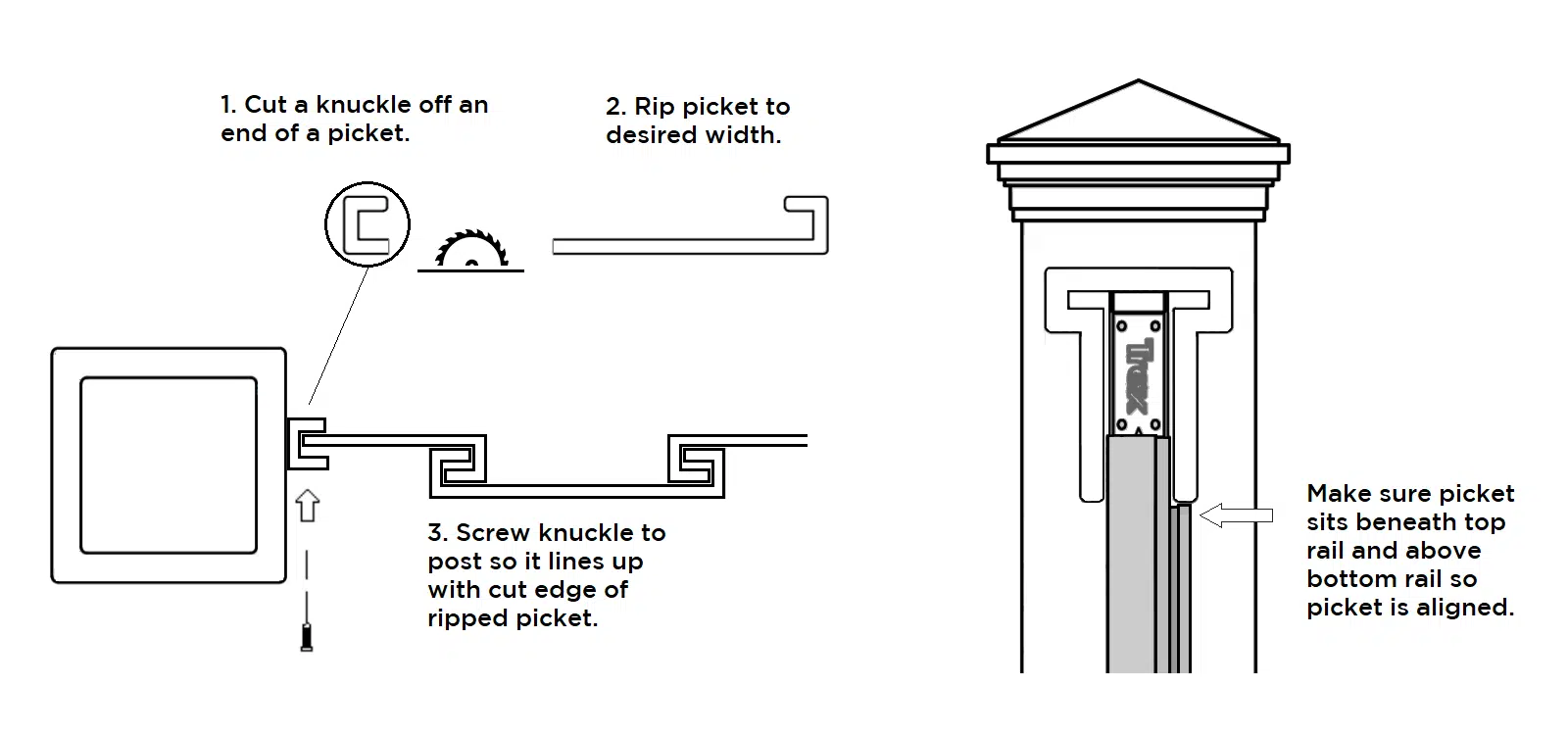
Horizons:
As was mentioned with Seclusions, shortening the span of the fence can be accomplished by cutting the composite and steel components to the desired length. Because the pickets are oriented horizontally, there is no need to adjust the spacing of the pickets. However, some adjustments may be necessary if you are trying to change the height of the fence. Of course, you can cut the material and remove any amount of pickets that you need to. But in the case of ripping or cutting the picket to adjust spacing, cutting or ripping the picket is discouraged except for in the case of the last picket.
The steel bottom rail is hung over the last picket, and then the rail itself is screwed into the composite material. When the pickets are manufactured, the material is extruded to the proper dimensions in order to provide an approximate 1” gap between the ground and the steel bottom rail. But these dimensions are nominal, and there are times when the fence body is too long and the bottom rail will hit the ground without an adjustment. In these cases, cutting the last picket is a suitable solution.

The ripped (or cut) end of the picket can be inserted into the bottom rail and then attached with screws. This allows you to make adjustments to the bottom of your fence, keeping it from direct contact with the ground. This also gives you an added level of variability in adjusting the height of your fence if desired. Our Horizons Installation Guide provides more details in regards to general installation, measurements, instructions, etc.
 So, in summary, ripping your Trex picket is not recommended in almost all applications. We do recommend it only in the case of adjusting the bottom of your Horizons fence. In Seclusions, the “C” channel design of the pickets is a critical element of the fence design. You can achieve the desired width for your fence section by cutting the material and spacing out the pickets accordingly, and then using finish nails or composite screws to secure any gaps between the interlocking “knuckles” of the pickets.
So, in summary, ripping your Trex picket is not recommended in almost all applications. We do recommend it only in the case of adjusting the bottom of your Horizons fence. In Seclusions, the “C” channel design of the pickets is a critical element of the fence design. You can achieve the desired width for your fence section by cutting the material and spacing out the pickets accordingly, and then using finish nails or composite screws to secure any gaps between the interlocking “knuckles” of the pickets.
Of course, if you ever have any questions, you can call our team at 877-700-8739 and we would be happy to help you out with your installation.
How do I make scratches and scuff marks on my Trex fence less visible?
During shipping, installation, or even after the fence is up, scratches and scuff marks can appear any material, including Trex. These typically become much less visible after weathering (which typically takes a season of exposure to sunlight). However, to minimize the appearance of these scratches and scuff marks sooner, using Windex or WD-40 on the affected areas. This will darken the material and will lighten with the rest of the fence as it weathers. Spray a small amount of Windex or WD-40 on a rag and lightly rub into the affected area sufficiently to darken the material. Do not use too much of the spray or it will leave a noticeable spot on your fence until it weathers off.
Note: It is best to test these methods on a scrap piece or a small, less noticeable area of your fence first to make sure you get the desired results.
Do horizontal fences sag?
Horizontal fences are more likely to sag than vertical ones if the boards are not properly supported. Most horizontal fences have spans of approximately 6 to 8 feet between posts, so the horizontal boards do not have support in between. That’s why it’s important to choose a horizontal fence design that has the necessary support to avoid sagging. For example, Horizons, a horizontal fence that combines Trex composite components with a metal frame from FDS, has two design factors to help reduce sagging and bowing. The Horizons frame system connects the top and bottom to sturdy metal rails while the pickets are secured between two vertical rails on each side. The pickets themselves interlock reducing mobility and helping to keep the shape of the fence. Horizontal fences that do not have this type of support are more prone to sagging and should be avoided. This is true not just for wood but for horizontal fences that are made from composite decking boards as opposed to the composite fencing boards used in Trex fence systems. That is why FDS designed the Horizons frame system in onjunction with Trex’s composite fencing components rather than decking boards. Visit Trex Horizons to learn more about the advantages and virtues of our horizontal fencing.
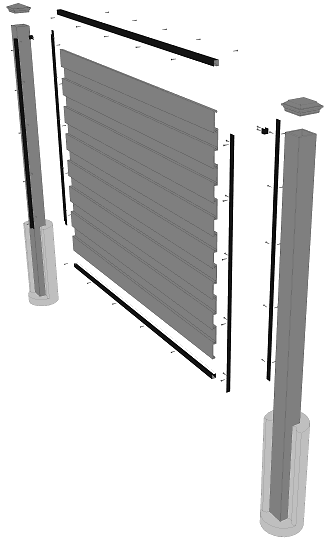
The Horizons frame system is designed to resist sagging for horizontal Trex fences.
How do I fill holes in the fence materials?
If you have holes in your Trex posts or rails, you can easily patch them. Most holes can be filled with very little visibility after the repair. If you have very large holes or the holes are in the pickets, you may need to replace the component.
Methods of filling holes in Trex composite components
Small holes with mushroomed material remaining
If the hole is very small, the mass that surrounds the hole has usually been displaced and has risen above the surface of the Trex material. Pinch together the mass that has mushroomed out of the hole and press it back into the hole. Lightly tap the material with a hammer to flatten it.
Medium size holes
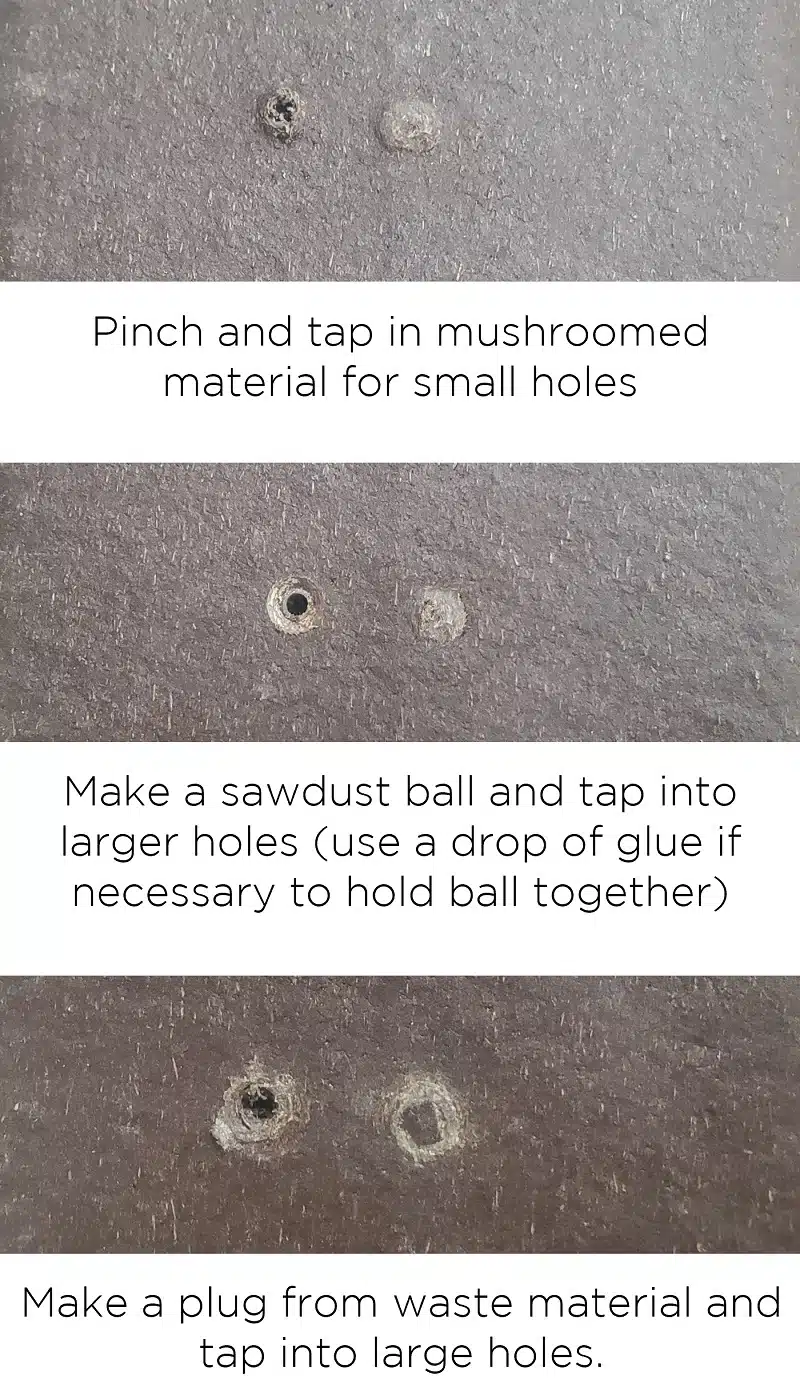
Does composite fencing expand?
Most materials, including composites, will expand to a degree when exposed to heat. This isn’t necessarily a problem if the product is designed to accommodate expansion and the fence is installed properly. Trex fence systems are designed to give the material room to move without negatively affecting the integrity of the fence. The interlocking system allows the fence to shrink and expand without causing the boards to separate or warp. It is important, however, that sufficient room is left for the pickets to expand, especially on the horizontal fencing. Follow the installation guides to ensure your pickets are installed properly.

How do I hide the gap between my gate panel and posts?
When a Trex gate panel is installed, a gap is left between the panel and the posts. This is necessary to allow the gate panel to function properly. The optimal gaps between the posts and panels is 1″ on either end of the gate. If the gap were smaller, the hinges and/or latches would bind or the gate would rub during the natural expansion and contraction of the composite material.
If you have concerns about being able to see through the gap, here is a tip to help you fill in the gap without interfering with the performance of the gate.
-
- Hang and adjust your gate as instructed in the installation guide.
-
- Cut off the edge of a picket (called the “knuckle”) to create a long strip that is 3/4″ deep x 1″ wide.
-
- Use screws to attach the strip to the post opposite the direction the gate swings. Pre-drill holes so the material doesn’t split.
-
- Make sure the strip will not interfere in any way with movement of the gate and hardware.
-
- On the latch side, you will need to cut the strip into two pieces and put them above and below the latch.
- Do not attempt to put the filler strips in between the gate panel and posts. When the gate material expands, the gate will no longer be able to open if you do.
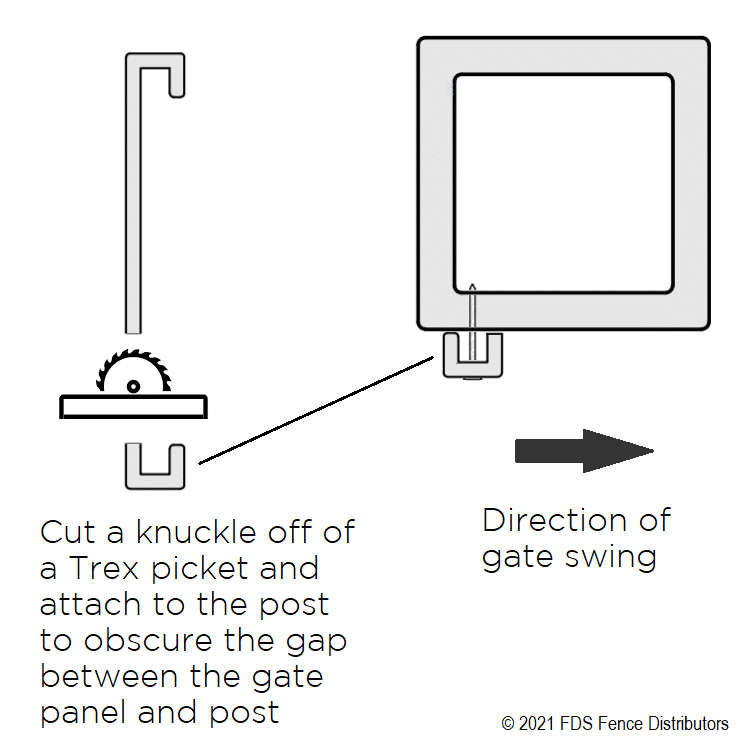
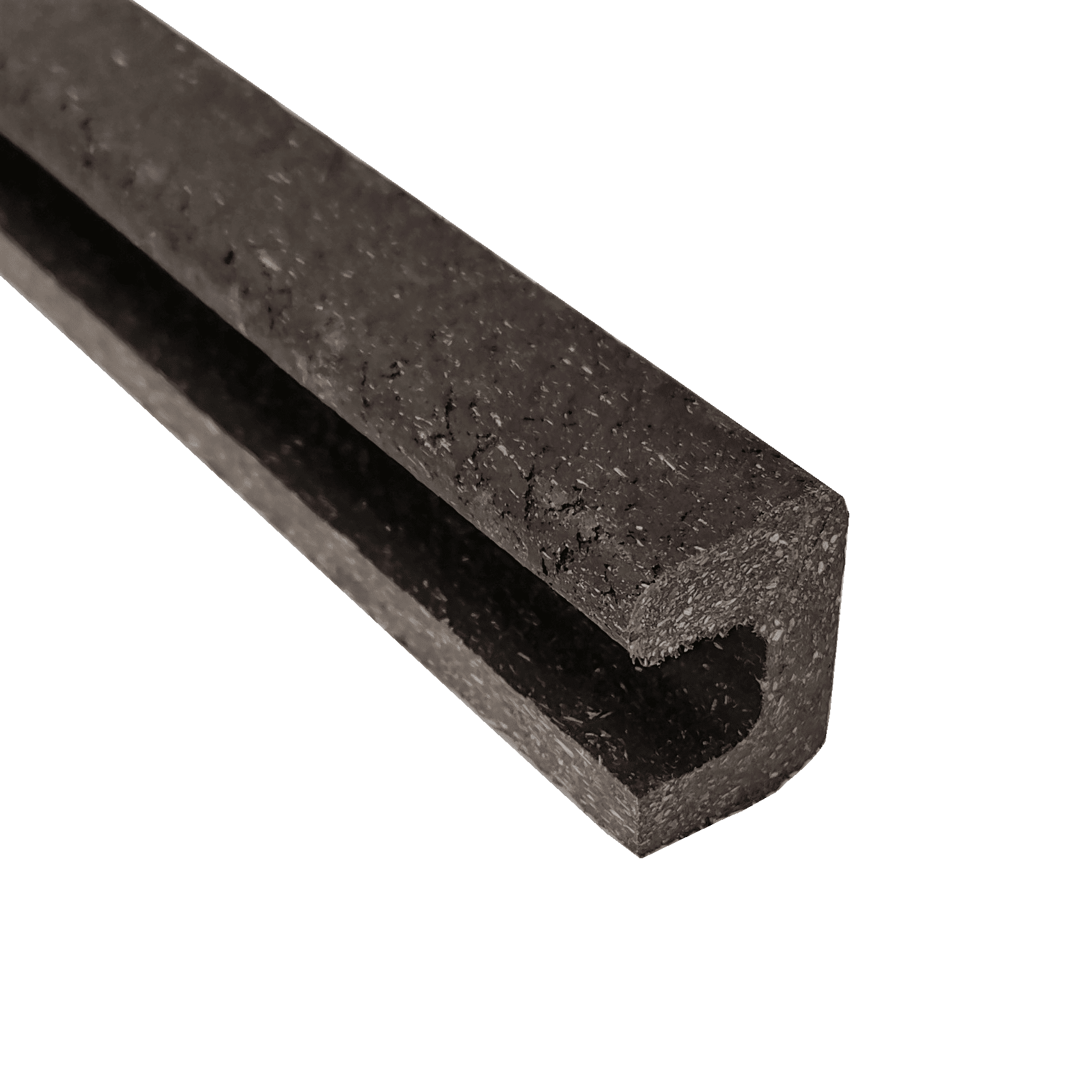
Can I buy Trex Fencing in Canada?
Trex Fencing can be purchased through special order for shipments into Canada. It should be expected that there will be additional costs associated with freight and customs. Additionally, all of the logistics associated with shipping brokers and getting the material across the border are the responsibility of the buyer. To assist you, here is information to help you place and receive your order.
CUSTOMS
You will need to make arrangements with a customs broker to assist you in getting the product from the United States. Customs import fees and provincial taxes are handled by the customs broker and paid by the buyer. If you do not already have a customs broker, contact these companies:
- Summit Customs Brokers: 604-278-3551
- Hemisphere: 416-252-5661
- Cole International: 403-262-2771
SHIPPING
- Must deliver to commercial business or terminal. Residential delivery is not available.
- Base shipping rates for job lot orders:
- $500 to British Columbia (BC), Alberta (AB), Saskatchewan (SK), & Manitoba (MB).
- $750 to Ontario (ON) & Quebec (QC).
- $1000 to New Brunswick (NB), Nova Scotia (NS), & Prince Edward Island (PE).
- Truckload shipments & other provinces require custom quotes.
- Payment options are wire transfer and credit card. ACH check payments are not an available option.
- Capital One Trade Credit and other payment terms are not available to Canadian companies.
- All pricing is given in USD.
How do I get green algae off my Trex fence?
Green algae can grow on virtually any surface where it has a food source, typically particles of decomposing materials such as small flecks of decaying leaves or grass that have stuck to a surface. To get green algae off your fence, there are several solutions.
A simple, non-toxic approach is to scrub your fence with a mixture of vinegar and water and let it sit on the fence for an hour before hosing it off. This will typically kill most of the algae. Since vinegar is acidic, it could affect sensitive plants, so you may want to consider covering them before cleaning your fence. If this method doesn’t take care of the problem, a more aggressive home remedy to remove the green algae off your fence is to mix eight parts water, eight parts peroxide, and one part Dawn dish soap. Scrub the mixture onto the surface of the fence and hose it off. Since peroxide is a strong chemical, follow recommendations for safety precautions and treatment. You may also want to make sure your work won’t negatively affect the plants around your fences. Take measures to protect them before applying the solution.
An additional option is to use a product called a deck brightener which contains oxalic acid (a wood bleach). This will typically kill all of the algae but it does have the propensity to lighten the material it is used on, so be aware your fence color may alter. If this happens and you want to freshen the color, you can paint or stain your fence. Trex is porous so paint or stain will adhere to the material. It’s always a good idea to test any of these solutions on a small area of your fence to make sure you get satisfactory results before you clean the entire fence. You can visit our Fence Care Guide on our website for help on a variety of maintenance situations
How do I get mold and mildew off of my Trex fence?
Mold and mildew are microscopic fungi that often grow on surfaces where conditions are right and organic mass (microscopic organic particles that contain cellulose like pollen or decaying plant debris) is available to consume. Mildew is a particular type of mold so for purposes of this topic, we’ll group these types of fungal growth under the generic term “mold.”
Mold requires a warmer, humid climate to thrive. Shady spots with high moisture content in the air are areas that are particularly vulnerable to growth. Organic particles can exist in water, so water that is sitting on the surface of the material and does not evaporate quickly can give mold a sustainable source of food and humidity to grow. This is the reason we encourage customers to open their shipment as soon as possible after orders arrive to reduce the risk of letting mold take hold.
If the area where your fence is installed is prone to providing an environment that’s friendly to mold growth, you will need to perform periodic maintenance to keep the problem under control. While you are removing the existing mold, take measures to clean up the space to remove the mold’s food sources and give the space as much circulation and sunlight as possible by cutting back overgrowth.
To get mold or mildew off your fence, you can employ a variety of methods. These organisms do not feed on Trex itself, but a build up of microscopic organic materials such as grass clippings or pollen can settle on the fence and this can attract mold which in turn attaches itself to the fence. The first thing to evaluate is what you can do to change the environment where the mold is growing to reduce or eliminate regrowth. That may mean trimming back bushes or cleaning up organic debris that has built up around the fence on a regular basis.
Once you’ve cleaned up the affected area, start with a simple step of cleaning the fence with soapy water and a scrub brush. Mold will grow into pores on the fence surface so scrubbing may take some efforts but you will want to do as thorough a cleaning job as possible to reduce the chance of mold coming back.
If this is not effective, there are more aggressive options. Before applying any potential solution, test a small area of your fence to see if it gets the mold off with acceptable results. Try a white vinegar solution to kill the mold. Fill a spray bottle with equal parts water and white vinegar to create a solution. Spray the solution on the fence and use a soft bristle brush to scrub in the vinegar. Let the solution sit on the fence for an hour. Since the acid in vinegar can be harmful to sensitive plants, consider protecting the space with plastic sheets around your fence before performing the cleaning. Hose off the solution and mold once you are done scrubbing.
The white vinegar solution is usually very effective but if it doesn’t produce the results you need, contact your local garden supply or home improvement stores and ask for help recommending a biocide that is specific to mold and mildew control. Follow the directions for application and safety.
For additional consideration, there are even stronger cleaners for particularly tough areas that have been affected by mold. These are usually products containing some level of sodium hypochlorite (bleach) and detergent. View Trex’s Mold Technical Bulletin for additional details on removing mold growth on your Trex products.
Looking for more ideas on cleaning your Trex Fence? View the Care & Cleaning Guide on our website for help on a variety of other maintenance needs.
What is Trex Fencing (and what it isn't)?
-
- Trex is an integrated system of extruded components.
-
- It is not dimensional composite lumber like decking.
-
- If you are looking for composite pickets only, the Seclusions pickets are made to interlock. They are not flat boards to mount to back rails, although they could be attached this way by screwing through the edges.
-
- Trex is a composite materials brand. If the profiles you want are anything other than what can be found on TrexFencingFDS.com or Trex.com, they are not Trex profiles.
-
- If the Trex Seclusions picket simply won’t work for your project, you could look into Trex composite decking boards. Just so you know, they are a full 1″ so they are quite heavy. We don’t work with the decking profiles so visit Trex.com to find a supplier or contractor near you.
-
- We do not sell competing composite products and aren’t able to help you source them. Other composite manufacturers are typically short-lived so unless you are using actual Trex brand materials, we aren’t able to provide support for replacement parts in the future.
- If you have a spec and it is not calling specifically for the Seclusions design, we recommend upgrading to Seclusions. If you require technical documentation, you can find shop drawings, installation guides, product information, pictures, videos and other resources on our website.
Is it normal for Trex to move in the wind?
Yes, Trex composite material is composed of particles that are bound together by proprietary adhesives. These adhesives are flexible and over the span of several feet there can be significant movement in the material during high wind events. This is more pronounced with taller
In general, flexibility is actually a positive element of the fence. Without the ability to move with bursts of high winds, fence posts could snap which is one reason why Trex tends to do better than wood in similar environments. The flex in the fence doesn’t guarantee the posts won’t break or pickets won’t blow out, but it does significantly reduce those possibilities.
REDUCING MOVEMENT IN THE FENCE
If the footers are sufficient to keep the fence posts plumb and concerns about movement still exist, an option is to stiffen the posts with an internal insert such as our steel post stiffeners (see section G).
Although the design of the pickets makes them capable of withstanding exceptionally high winds, it is possible that they can displaced by wind. If the pickets screwed to the posts become dislodged or there are concerns about this happening, add additional screws. It is also a good idea to add screws through the top and bottom rails into the pickets a few times in a section and to make sure the top rail is screwed down onto the brackets. The additional fasteners will help secure the material against the effects of higher than normal wind loads.
TREX WIND LOAD PERFORMANCE
The Trex wind load evaluation is a performance test conducted to demonstrate the capabilities of the fence and to give customers a comparison point with other products. While Trex has superior wind performance properties, the wind load test does not establish a guarantee of performance in the field because it is impossible to replicate the volatility of how wind acts outside a controlled environment. Trex does not warranty Acts of God, under which wind would fall.
What are the dimensions of the steel post used with Horizons?
For our Horizons fencing line, we do offer steel posts in addition to our standard composite Trex posts.

These posts are only offered in 9′ lengths and are 2.5″x2.5″ 14ga. The only color they come in is matte black.

These steel posts are a great option for customers looking to maximize the modern, contemporary design that Trex Horizons offers.

What can I use for deck skirting?
To solve this solution, many homeowners elect to install skirting around the deck, usually out of wood boards to create an appealing barrier.
 Of course, if you use wood to skirt your deck, you will need to factor in the time and cost to maintain the skirting’s beauty and function. If you’re using a composite material to build your deck, let’s say, oh I don’t know – Trex – for example, the last thing you’re looking for is probably maintenance.
Of course, if you use wood to skirt your deck, you will need to factor in the time and cost to maintain the skirting’s beauty and function. If you’re using a composite material to build your deck, let’s say, oh I don’t know – Trex – for example, the last thing you’re looking for is probably maintenance.
Fortunately, this is yet another area where Trex Fencing really shines.
 Trex Fencing offers full privacy to keep animals out from under your deck, as well as the wonderful low-maintenance qualities to compliment your composite deck. You will never need to paint or stain the fencing, and it can handle the elements much better than wood, or even vinyl, can.
Trex Fencing offers full privacy to keep animals out from under your deck, as well as the wonderful low-maintenance qualities to compliment your composite deck. You will never need to paint or stain the fencing, and it can handle the elements much better than wood, or even vinyl, can.
Trex Pickets interlock, greatly decreasing the installation time when compared to wood as well.


Does composite fencing sag?
Whether or not a composite fence sag is dependent on the design of the fence. Composite fences that do not use metal reinforcement for rails are most likely going to sag over time. Trex Fencing is built with a sturdy aluminum bottom rail that supports the weight of the fence. The rail is covered by composite boards, hiding the aluminum. This gives you the aesthetic wood-like appearance of Trex with the reinforcement necessary to protect the fence from sagging.


Our installation resources offer more information, and can be accessed by visiting https://www.trexfencingfds.com/resources/seclusions-install-guides/
Does composite fencing shrink?
With wood fences, boards will shrink as they weather because moisture evaporates out of the boards. Composite fence boards act differently because they are dense and won’t dry out as they age. That’s why composite fence boards that are butted together tend to bulge and warp when the fence material heats up in the sun. If you prefer a composite fence system, choose Trex. The fence boards are specifically designed to maintain the full privacy look as the boards expand and contract. Trex accommodates shrinking by using an ingenious interlocking picket system that gives the fence the necessary movement it needs to help the material avoid separation. Trex is also a better option for wood fence boards if you want to avoid gaps altogether.

 Visit our article about Trex’s Smart Design to learn more about the benefits of our Trex pickets.
Visit our article about Trex’s Smart Design to learn more about the benefits of our Trex pickets.
Does Fiberon make fencing?
Fiberon no longer manufactures fencing. The company discontinued its fencing line in 2019. Consumers looking for a composite fencing alternative to Fiberon (also known as Woodshades at Lowe’s and Veranda composite at Home Depot) should consider Trex. Since 2005, Trex fencing has been in continuous production and is available by special order in all markets and through major box stores including Lowe’s and Home Depot.
Does Lowe's offer installation services for Trex Fencing?
Our product is considered a special order item, and thus you can place an order through Lowe’s for our material. In that case, they would place the order for you and we would ship the material to their store. For added convenience, we also offer our product on their website. If that works best for you to special order it, then that is great.

An added benefit of ordering through Lowe’s is that they can also coordinate the installation of your fence project. They work with local professional installers, which means Lowe’s can become your one-stop shop for getting your fence project done. Contact your local Lowe’s store and ask for the PSE (the Lowe’s exterior salesperson). He or she will meet with you at your property and write up an estimate based on your property layout, the products you choose, and the specific requirements for your project. If you are considering a Trex fence, your Lowe’s PSE will be able to answer many of your questions. For additional support or to clarify any questions about Trex fencing availability through Lowe’s’ national sales program, contact our team at 877-700-8739.

However, you can buy the fencing directly from us on our Online Shop if you’d like to take on the fence project as a DIY. We offer a plethora of Installation Resources on our website to help you on your DIY journey. If you would like a little more guidance, our team can help you out every step of the way from building you a quote, to helping you order the material, to coordinating the shipping. One major benefit of going directly through us is that we designed the product and know it inside and out. We can help ensure that you order exactly what you need, and are a resource for you during the installation of the fence itself.

Importantly, how you order depends heavily on how the fence is getting installed. If you are taking it on as a DIY, then ordering it either through us or a big box store will work great. If you are wanting to have it installed professionally, than the contractor will want to be the one to order the material in most cases. Again, that is where Lowe’s really shines, because they can offer you both services. Bottom line, we strongly recommend deciding which route you want to go before you place an order for the material. Because there are multiple considerations to keep in mind, feel free to call our team at 877-700-8739.
Does PVC fencing fade?
Even with UV inhibitors, most plastics fade over time. Historically, this is the reason vinyl or PVC fencing was only manufactured in light colors like white or tan. New vinyl fences have more advanced UV inhibition to help reduce the fade. When considering a fence for your property, fading may not necessarily be a factor if you understand how the color will transform over time. For example, if you prefer the look of a light coastal cedar fence, a grey PVC or composite fence will have that appearance after fading. The bigger issue than fading is whether or not the fence will retain its color or change its color over time. Most PVC and composite fences will fade, but they will not lose their color or change to another color throughout the weathering process.
Does Timbertech make fencing?
Timbertech discontinued its fencing line around 2010 choosing instead to focus on its core decking lines. Like Fiberon and other composite manufacturers, Timbertech was unable to create a viable market for its fencing product. Trex, on the other hand, introduced its fencing line in 2005 and has continued to manufacture its fencing without interruption since then. The design of the Trex fencing system is the primary reason for its longevity. Rather than attempting to emulate a standard wood fence design like Timbertech’s Fencescapes product or cut corners by only selling a flat composite picket as some composite manufacturers do, Trex engineered a fence system that leverages the best attributes of its composite material with a design that is not only aesthetically stunning but has durability benefits. To make sure the fence is available and affordable everywhere, Trex partners with FDS Fence Distributors to distribute its product nationally. FDS has built a vast distribution network through contractors and suppliers so Trex is available in every market for DIY and installation customers.


Visit Trex vs Other Composites on our website in order to learn more about how Trex compares to other composite material out there.
Does Trex Fencing age well?
Trex Fencing does age extremely well when compared to wood and vinyl fencing. When you install a wood or vinyl fence, the material immediately begins to depreciate. Wood will rot and twist with time. Vinyl fencing can turn an unsightly yellowish over time. Scuffs and abrasions add up over time for both fence materials, and wood fencing requires consistent maintenance to keep it looking anywhere close to new. Vinyl fencing is notorious for becoming brittle and cracking over time.


Trex is designed to resist rotting, splitting, and decay and is covered under the Trex Fencing Warranty. While Trex Fencing’s color will fade over time, the material fades to an aesthetically pleasing shade and then never loses its color.

Scuffs and abrasions on a Trex Fence actually tend to blend in over time since the color of the fence is dyed throughout the material, which means that the scuffs will weather and even out the coloring. This also means that you will never need to spend a single Saturday painting or staining your fence.
 Trex Fencing material is considerably thicker and more durable than most vinyl fencing, which means that it resists cracking and won’t become brittle with age. The cherry on top of all of this is how simple it is to clean. In most cases, hot soapy water and a soft bristle brush will effectively remove dirt and grime from the fence. With a little bit of consistency, you can keep your Trex Fence clean with minimal effort. When compared to other popular fencing material, Trex repeatedly blows the competition away. Trex is built to not only last, but to look amazing for years and years to come.
Trex Fencing material is considerably thicker and more durable than most vinyl fencing, which means that it resists cracking and won’t become brittle with age. The cherry on top of all of this is how simple it is to clean. In most cases, hot soapy water and a soft bristle brush will effectively remove dirt and grime from the fence. With a little bit of consistency, you can keep your Trex Fence clean with minimal effort. When compared to other popular fencing material, Trex repeatedly blows the competition away. Trex is built to not only last, but to look amazing for years and years to come.
Does Trex Fencing allow returns?
Because of the size of the product, and because Trex Fencing is a special order item, we do not allow returns. We strongly recommend that customers review their project and the amount of material ordered before purchasing the fencing. Our team of experts is available as well to help you calculate material needs. You can give us a call Monday-Friday, 8-5pm at 877-700-8739.

Our website also has resources such as our Cost Estimator and Instructions in order to give you some guidance if needed.
Does Trex Fencing come in black?
Trex Fencing does not come in black. Our three colors available are Woodland Brown, Saddle, and Winchester Grey. Trex decided on which colors to produce their fencing materials in through extensive research and focus groups. The results of these efforts indicated that consumers were most interested in natural tones reflecting browns and stony hues. So while black is not currently offered within the Trex Fencing portfolio, there is the chance that additional colors will be added if research findings ever justify the change.

For those customers who love Trex but also really want black, you do have the option of painting the fence system, although this will require maintenance in the future which may not be worth the extra effort and money. For more information, visit Trex Fencing Colors on our website.
Does composite fencing discolor?
Composite fencing will usually experience changes in color as the fence weathers, including Trex. This weathering process is natural and does not effect the integrity of the fence itself. As a way to counteract the fading process, the product is over-pigmented when it is manufactured. As a result of this practice the fencing arrives significantly darker than it will be once it has had an opportunity to weather. As Trex Fencing is exposed to UV light, the product will fade to its true weathered color. After initial weathering has occurred, typically within a season of exposure to sunlight, any additional fading is minimal and Trex will retain color throughout its life. You can learn more under the resource tab on our website.

Could I install a Trex Fence myself, or do I need a professional to do it for me?
Trex Fencing is considered a DIY product, and we provide plenty of installation help every step of the way with videos, pdf’s, as well as our team of experts who can answer any questions you have during office hours. That being said, an installation of Trex Fencing does require you to have a certain level of comfortability with measuring, cutting, concrete mixing, post setting, and other basic construction skills. We highly recommend that you review the installation material and assess your ability to complete the project before purchasing Trex Fencing. If you decide to go the route of hiring a contractor, we can help with that process too!

Can you use Trex for fencing?
Trex Fencing is the premier composite alternative to wood fencing. Seclusions and Horizons systems are made specifically for fencing applications. The materials are not converted decking boards. They are specifically designed and engineered for fencing and will outperform other types of fences including wood and vinyl.

Are brackets used for Horizons the same as for Seclusions?
Both our Seclusions and our Horizons fence systems use brackets during installation. The design and function of the brackets, however, are different between the two systems.
- First, let’s go over our Seclusions brackets:

Seclusions brackets are made of a plastic material, and are curved at the top. 4 brackets are used per section of fence – 2 brackets at the top and bottom of each post facing each other.

The top and bottom rails are situated over the brackets during installation.
- Now, let’s move on to Horizons brackets:

In contrast to Seclusions brackets, Horizons brackets are actually made out of steel. 2 brackets are used per section of fence – 1 bracket at the top of each post facing each other.

Very important – the design of the two brackets make them incompatible with the other fence system. Horizons brackets cannot be used with the Seclusions system and vice versa. We would recommend that if you ever need to order individual brackets for your project, you verify that you are buying the correct bracket for the fence style you are installing before purchasing.
Can Trex Fencing be sloped?
Our Trex Seclusions fence line can easily be adjusted to follow the contour of the landscape. Racking – or sloping – your fence can be done by making the needed cuts to your rails and pickets. Trex Horizons is also suitable for sloping, but the nature of the steel framing kit is such that more cuts will be necessary, and you will need to cut through steel components rather than composite material.

So, while Horizons could be adapted for changes in grade (slope) of a property by cutting the components, consider that the horizontal lines of the fence are best oriented parallel to the earth’s Horizons (thus the name). In its standard configuration, stair stepping is the best look for the fence.
 If you are looking to follow the grade of your property, Seclusions is the better option. It installs more easily on slopes requiring very little cutting in most situations. Feel free to review our installation resources for more details: Seclusions | Horizons
If you are looking to follow the grade of your property, Seclusions is the better option. It installs more easily on slopes requiring very little cutting in most situations. Feel free to review our installation resources for more details: Seclusions | Horizons



